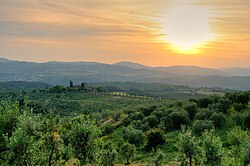
The Arno is a river in the Tuscany region of Italy. It is the most important river of central Italy after the Tiber.
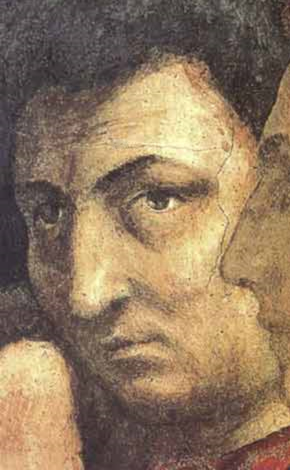
Masaccio, born Tommaso di Ser Giovanni di Simone, was a Florentine artist who is regarded as the first great Italian painter of the Quattrocento period of the Italian Renaissance. According to Vasari, Masaccio was the best painter of his generation because of his skill at imitating nature, recreating lifelike figures and movements as well as a convincing sense of three-dimensionality. He employed nudes and foreshortenings in his figures. This had seldom been done before him.

Vallombrosa is a Benedictine abbey in the comune of Reggello, about 30 km south-east of Florence, in the Apennines, surrounded by forests of beech and firs. It was founded by Florentine nobleman Giovanni Gualberto in 1038 and became the mother house of the Vallumbrosan Order.

San Giovenale Triptych is a 1422 painting by Italian Renaissance artist Masaccio, housed in the Masaccio Museum of Sacred Art at Cascia di Reggello, in the Metropolitan City of Florence. The triptych is the first work attributed to Masaccio and the earliest known painting essay using the geometric Renaissance perspective.

Greve in Chianti is a town and comune (municipality) in the Metropolitan City of Florence, Tuscany, Italy. It is located about 31 kilometres (19 mi) south of Florence and 42 kilometres (26 mi) north of Siena.

San Giovanni Valdarno is a town and comune in the province of Arezzo, Tuscany, central Italy, located in the valley of the Arno River.

Montevarchi is a town and comune in the province of Arezzo, Tuscany, Italy.

The Vallombrosians are a monastic religious order in the Catholic Church. They are named after the location of their motherhouse founded in Vallombrosa, situated 30 km from Florence on the northwest slope of Monte Secchieta in the Pratomagno chain. They use the postnominal abbreviation O.S.B. Vall. to distinguish themselves from other Benedictines, who generally use the abbreviation O.S.B.
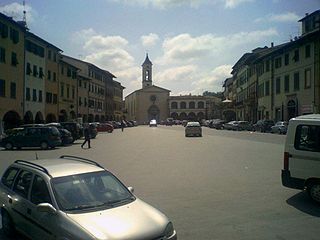
Figline Valdarno is a frazione in the comune of Figline e Incisa Valdarno in the Metropolitan City of Florence in the Italian region of Tuscany, located about 25 kilometres (16 mi) southeast of Florence. It is the birthplace of Marsilio Ficino.
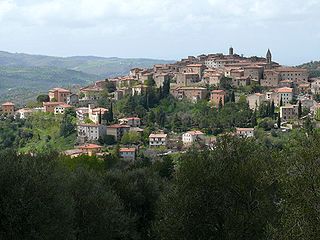
Seggiano is a comune (municipality) in the Province of Grosseto in the Italian region Tuscany, located about 100 kilometres (62 mi) south of Florence and about 40 kilometres (25 mi) northeast of Grosseto.

Ignazio Hugford, or Ignatius Heckford (1703–1778), was an Italian painter active mostly in Tuscany in an early Neoclassic style.
Vallombrosa is a toponym which indicates both a forest and a frazione, located within this forest, in the territory of the Commune of Reggello, in the Metropolitan City of Florence, in the Italian region of Tuscany.

The Arboreti di Vallombrosa are seven arboreta located within the Forest Demaniale Vallombrosa near the historic Vallombrosa Abbey founded in 1036 by St. John Gualbert of Visdomini, heavenly patron of the Italian Forestry Corps. They are located in Vallombrosa, Reggello, Province of Florence, Tuscany, Italy, operated by the Carabinieri Department for Biodiversity of Vallombrosa. During the summer months there are free guided tours every day, in all other periods upon prior request.

The railway station of Figline Valdarno serves the Tuscan town of Figline Valdarno. The station situated on the Florence–Rome railway line, 40 km from Florence, on the stretch between Florence and Arezzo. It is mostly used by commuters coming from Figline Valdarno, Reggello and Pian di Scò going to Florence.

The Vallombrosa Altarpiece is a painting by the Italian Renaissance painter Pietro Perugino, dating to 1500–01. It is housed in the Accademia Gallery of Florence, Italy.
Villa Pitiana is a historic estate in the province of Florence in Italy.

Faella is a frazione of Pian di Scò in the Province of Arezzo in the Italian region Tuscany, located about 30 km southeast of Florence and about 35 km northwest of Arezzo, in the Valdarno.

Niccolò Lapi was an Italian painter of the Baroque period, active mainly in Tuscany.
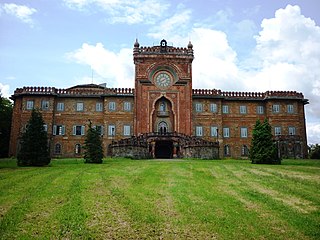
Sammezzano, or the Castle of Sammezzano, is an Italian palazzo in Tuscany featuring Moorish Revival architectural style. It is located in Leccio, a hamlet of Reggello, in the Province of Florence.

The House of Guidi was a Tuscan aristocratic family prominent in the region during the Middle Ages. Descended from Tegrimo Guidi, the family practised partible inheritance and in the thirteenth century began to split into separate cadet lineages.
